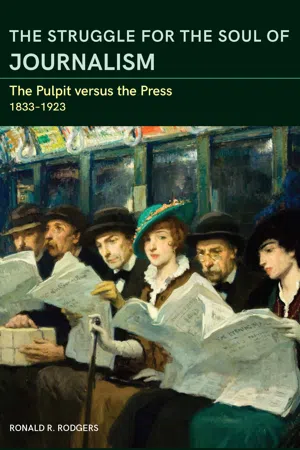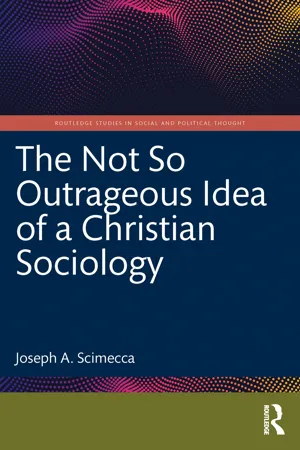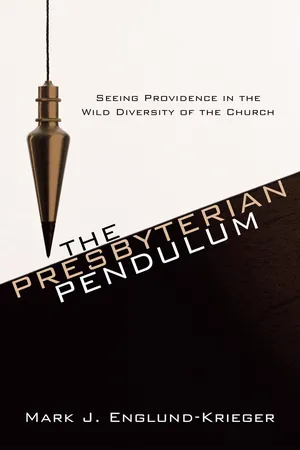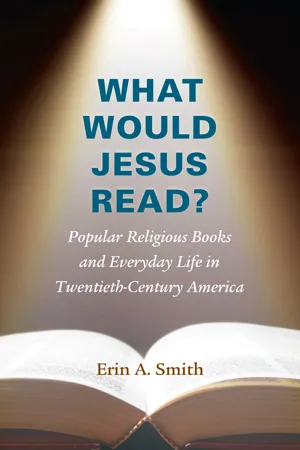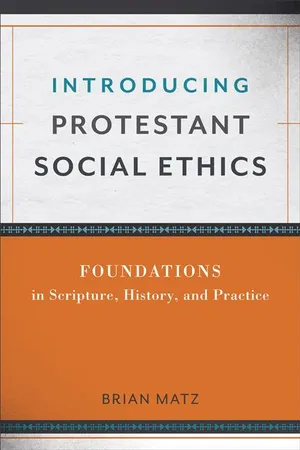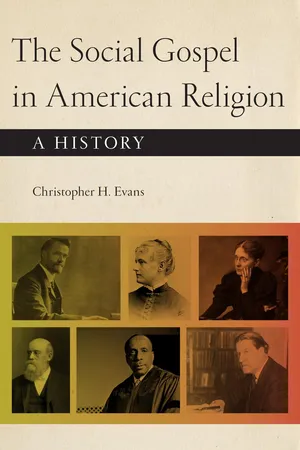History
Social Gospel Movement
The Social Gospel Movement was a 19th-century Protestant movement in the United States that sought to apply Christian principles to social problems such as poverty, inequality, and injustice. It emphasized the importance of addressing societal issues and promoting social reform, and it had a significant impact on the development of progressive social policies and activism in the country.
Written by Perlego with AI-assistance
Related key terms
8 Key excerpts on "Social Gospel Movement"
- eBook - ePub
The Struggle for the Soul of Journalism
The Pulpit versus the Press, 1833-1923
- Ronald R. Rodgers(Author)
- 2018(Publication Date)
- University of Missouri(Publisher)
21 The Social Gospel MovementSo the question, to begin, is this: What was the Social Gospel? And the answer, as the Reverend John A. Patten noted in 1920, is both anchored to a fundament and adrift in the context of the times in which the question was asked because “every age calls for its own emphasis.”22 However, the movement’s “permanent truths may be expressed in such phrases as social justice, the brotherhood of man, universal peace, and the like,” wrote Patten, for many years the editorial secretary and literary superintendent of the British and Foreign Bible Society.23 Indeed, those are notions that can be enveloped in the Social Gospel’s theology that saw “God as a Social Being, closely identified with humanity, rather than an isolated Being, ‘at an infinite distance’”; that held that the human community was to be “understood in the light of racial religiousness, rather than racial depravity”; and that saw “Sin as Social Injustice.”24 And just as economic issues were no longer seen as lying outside the sphere of society, neither were religion and its role in the lives of men and women. Instead, God was immanent, and the concept of the “social” was the armature for a new theology in which “the hand of God is on the whole life of man, physical as well as spiritual.”25 At the risk of oversimplifying, the “New Theology” was “the religious articulation of the social movement” that, as one writer noted in 1908, “is now taking place in every country of the civilized world toward universal peace and brotherhood and a better and fairer distribution of wealth.”26 One contemporary scholar has described this notion of immanence as a fusion of the religious and secular and “the abandonment of a God conceived primarily as a transcendent judge, and the embrace of the world itself as the prime locus of salvation.”27 - Joseph A. Scimecca(Author)
- 2023(Publication Date)
- Routledge(Publisher)
At the end of the nineteenth and beginning of the twentieth centuries in the United States—the period in which the Social Gospel thrived—the Christian worldview, though threatened by secularism and materialism, held firm, unlike in Europe. Although the works of Freud, Darwin, Marx, and Nietzsche, were available, most Christians were unaffected by them, and defined or viewed American Protestantism with an emphasis on Original Sin and individual salvation, foreshadowing what would eventually be described as Fundamentalist Christianity.The Social Gospel Movement was a home-grown attempt to transform the theological emphasis on individual salvation into a social Christianity. Evans (2017 :2) defines the theoretical underpinnings of the Social Gospel as “an offshoot of theological liberalism that strove to apply a progressive theological vision to engage American social, political, and economic structures … in ways that advocated for systematic, structural changes in American institutions.” Shailor Mathews (1921 :416–417), one of the Social Gospel's early leaders advocated “the application of the teaching of Jesus and the total message of the Christian salvation to society, the economic life, and social institutions … as well as to individuals.” Essentially, “more than a traditional religious movement, the Social Gospel stepped outside the churches to intersect the political, social, and economic forces of changing America” (White and Hopkins 1976 :xi).The earliest statement of the credo of the Social Gospel in the United States has been traced to Stephen Colwell's 1851 book, New Themes for Protestant Clergy, in which he “blamed the slow progress of Christianity upon its preoccupation with creeds and doctrine rather than with true charity” (Hopkins 1940 /1967:6).The Social Gospel became more and more popular after the Civil War and a large public readership was reached in 1886 when Applied Christianity by Washington Gladden, an early leading figure in the Social Gospel Movement was published. Applied Christianity- eBook - ePub
The Presbyterian Pendulum
Seeing Providence in the Wild Diversity of the Church
- Englund-Krieger(Author)
- 2010(Publication Date)
- Wipf and Stock(Publisher)
1The Social Gospel Movement
A s the twentieth century dawned, the Social Gospel Movement1 pushed the pendulum in the Protestant churches. This movement lengthened the swing between different theological perspectives. The length of the pendulum’s swing, that is to say the distance between the theological poles in the Protestant mainline, has never diminished in the century since the advent of Social Gospel Movement. The American tradition of evangelical Christianity, which focused on the salvation of individual souls for Jesus was now counterbalanced with a bright, social Christianity. Within the Presbyterian Church we will see these opposite viewpoints in the ministry of Charles Stelzle and Charles Erdman. The social gospel was influential primarily in the old mainline denominations, whose dominance was in those places where the Industrial Revolution was changing everything. The proclamation of the social gospel was loudest in the Methodist, Presbyterian, and Congregational denominations. Individual salvation was not the focus of this revolutionary movement. The social gospel advocates preached about Christianizing society, addressing social concerns, redeeming economic practices, and ushering in the kingdom of God.Most important for our concern is that this movement brought a wider, broader, more comprehensive message into the churches. Now, clearly, the churches included a richer diversity. Opposite ends of the theological pendulum seemed contradictory. As the twentieth century dawned, the need for Christians to perceive the deeper message to which the wild swinging pendulum pointed was essential. The church struggled to hold itself together against centrifugal forces wanting to pull it apart. Possibly this is a struggle that could describe any era in Christian history. But we will see that this struggle for unity, the desire to see the providence in all the diversity is a special concern of twentieth-century American Protestantism. Prayerfully, the better vision provided by our hindsight and historical reflection will make the fight for unity a bit easier for us at the dawn of the twenty-first century. - eBook - ePub
A History of Religion in America
From the End of the Civil War to the Twenty-First Century
- Bryan Le Beau(Author)
- 2017(Publication Date)
- Routledge(Publisher)
But in exchange, God required men to be concerned with this life – its poverty, depravity, and injustice – as well as the afterlife, and to take responsibility for their brothers’ and sisters’ redemption, as well as their own. Some have argued that the Social Gospel was “a peculiarly American phenomenon in its interpretation of the Christian message and Church as having a role to play in the public sphere.” A few have insisted that the Social Gospel was never an organized movement but, rather, that it attracted those who wished to apply social Christian ethics to the pressing social needs of the day, as portrayed daily by muckraking journalists and photographers like Jacob Riis. 11 To this end, in 1908, on the heels of publication of Walter Rauschenbusch’s Social Gospel classic, Christianity and the Social Crisis (1907), the Federal Council of Churches (FCC), newly formed from mainline Protestant churches, adopted the “Social Creed of the Churches,” which called for measures to address the dehumanizing conditions of the industrial workplace, including the rights of workers to organize and bargain collectively, the elimination of child labor, and a shorter work week - eBook - ePub
What Would Jesus Read?
Popular Religious Books and Everyday Life in Twentieth-Century America
- Erin A. Smith(Author)
- 2015(Publication Date)
- The University of North Carolina Press(Publisher)
One: What Would Jesus Do?
Reading and Social Action This library is my church, and men and women of all creeds come here by the thousands.—Inside of the Cup (1913)Hegemonizing is hard work. —STUART HALLFrank Luther Mott, esteemed scholar of bestsellers in America, argues that “one cannot dip into the popular literature of the first two decades of the twentieth century without being impressed by the emphasis on the church and its problems.”1 Much of this literature was part of the Social Gospel, an ecumenical Protestant movement in North America in the late nineteenth and early twentieth centuries seeking to transform social institutions according to Christian principles. Sometimes called the “Third Great Awakening,” the Social Gospel was a response by liberal Protestants to the problems caused by industrialization, massive immigration, and urbanization. The religious expression of the Progressive movement, the Social Gospel had a major influence on the policies of Theodore Roosevelt and Woodrow Wilson, advocating for workers’ rights to collective bargaining; federal regulation of wages, hours, and working conditions; protective labor legislation for women and children; and the formation of a welfare state to mitigate the negative effects of unbridled capitalism. In part, Social Gospel leaders wished to bring working men and women into the church, but they also intended to bring about the kingdom of God (that is, a just social order) here on earth.2Although the Social Gospel is usually discussed through the nonfiction writings of its most prominent leaders, liberal Protestant ministers Washington Gladden, Richard Ely, and Walter Rauschenbusch, there is a sizable body of Social Gospel fiction that popularized the doctrines of these more learned writers. About one hundred Social Gospel novels were published around the turn of the twentieth century. Between 1886 and 1914, roughly three or four Social Gospel novels appeared every year.3 The most popular American novels include Charles Sheldon’s In His Steps (1897), Harold Bell Wright’s That Printer of Udell’s (1903), and Winston Churchill’s Inside of the Cup (1913). All of these novels are self-consciously about print culture, making clear that founding the kingdom of God here on earth depends on making appropriate use of books and literacy. These novels are rich resources, then, for uncovering the rules of reading and the networks of reading practices authors, ministers, and publishers urged on their Social Gospel readers in turn-of-the-century America. Moreover, the commentary and controversy they engendered offer testimony to some of the ways Social Gospel readers appropriated these texts as “equipment for living” their everyday lives.4 - eBook - ePub
Introducing Protestant Social Ethics
Foundations in Scripture, History, and Practice
- Matz, Brian(Authors)
- 2017(Publication Date)
- Baker Academic(Publisher)
In His Steps , by Charles Sheldon. In this excerpt from the book, the fictional Rev. Henry Maxwell laments to his congregation the recent death of a transient man whom he had turned away after the man asked him for assistance. Reverend Maxwell was determined not to make the same mistake again.Our motto will be, “What would Jesus do?” Our aim will be to act just as He would if He was in our places, regardless of immediate results. In other words, we propose to follow Jesus’ steps as closely and as literally as we believe He taught His disciples to do. And those who volunteer to do this will pledge themselves for an entire year, beginning with today, so to act.—Charles Sheldon, In His Steps (1896), 21In any case, the Social Gospel Movement began to pass from favor starting in the 1920s, and the decline accelerated in the 1940s. The first signs of change came with the shift among fundamentalist Protestants away from social concerns toward revivalism. Although mainline and fundamentalist Protestants initially shared many of the Social Gospel Movement’s concerns (and had joined together to build the types of institutions described earlier, such as the Salvation Army), by the 1920s fundamentalists had come to value more the type of work that was done by earlier evangelists such as D. L. Moody. Moody had argued that preaching for personal transformation was a more effective use of an evangelist’s time than the longer horizon required of those seeking changes in social structures. This decline in the Social Gospel Movement camp from the departure of fundamentalists accelerated in the 1940s with the departure of some even in the mainline Protestant communities. Neo-orthodox theologians shifted Protestant interests still further away from positivist views of human society with a renewed appreciation for the reality of sin and toward a concern with God’s transcendence as an ordering principle of individuals’ lives.Still, the Social Gospel Movement never went away. Protestants in civil rights movements (be they rights for racial minorities, for women and, in some corners, for sexual minorities) continue the use of social gospel language. Baptist minister Martin Luther King Jr. specifically credited Rauschenbusch as a significant influence on his thinking.30 The evangelical Protestant organization Sojourners, founded in 1971 and led still today by Jim Wallis, continues to promote the ideals of those in the Social Gospel Movement through its monthly publication, Sojourners . Also, the work of educators such as Glen Stassen (at Fuller Theological Seminary until his death in 2014) transmits the language of the Social Gospel Movement’s concern about economic and social justice to new audiences of Protestants.31 - eBook - ePub
The Disruption of Evangelicalism
The Age Of Torrey, Mott, Mcpherson And Hammond
- Geoffrey R. Treloar(Author)
- 2016(Publication Date)
- IVP(Publisher)
5. A SOCIAL GOSPEL?If conversionism and theology were two bridges from the private and church lives of evangelicals to society at large, social activism was another.1 This was the result from very early in the history of the movement of the application to public life both of what they learned from reading their Bibles and of the reflective and analytical powers developed in cultivating their spirituality. These impulses led to participation in various reform activities and philanthropic societies as evangelicals sought to enforce the ethics of the gospel. Their capacity to lead civilization and shape culture was shown by the historic high point of these movements of protest and reform, the abolition of slavery in the British Empire finally achieved in 1833, a work that was extended by the ‘abolitionists’ in the United States over the next thirty years. The language and methods of the anti-slavery campaigns were carried over into other causes as evangelicals grappled with a wide diversity of social and humanitarian needs caused by the processes of modernization. Wide-ranging engagement with society continued to build because it served basic evangelical ends. Practices perceived as sinful, an obstruction to the spread of the gospel or out of step with Protestant Christianity moved evangelicals to protest and campaign for reform. Across the second half of the nineteenth century such was the increase of sociopolitical involvement of evangelicals as the categories of what was integral to the gospel broadened that social activism was a further dynamic of fin de siècle - eBook - ePub
- Christopher H Evans(Author)
- 2017(Publication Date)
- NYU Press(Publisher)
If then we are to appreciate the full value of prophetic religion as a social force, we must turn to Jesus’ thought of the kingdom of God.” 1 Lyman’s assertion picks up on the ideas of many late nineteenth-century Protestant leaders like Washington Gladden, in identifying the kingdom of God as a concept that embodies Jesus’s social teachings for the modern age. Yet in many ways Lyman’s tone was more urgent than that of earlier social gospel leaders, as Lyman noted the inseparable connection between one’s personal faith and the struggle for social justice: “The direct, inward, intimate relation of the soul to God is one of religion’s supreme achievements, gained at the cost of great struggles with dogmatic authority, with the deadness of the letter, with formalism in worship and morals; an achievement never again to be lost so long as the Son of Man finds faith upon the earth.” 2 Lyman’s observation was written at a time when the social gospel had gained an increasing level of acceptance in many religious institutions and in the wider culture. In 1910 Ray Stannard Baker, one of the most prominent journalists of the Progressive Era, noted that religious faith would play an essential role in galvanizing various measures of progressive political reform—what Baker and others referred to as the “social awakening” occurring in many parts of the nation. In particular, he singled out Walter Rauschenbusch’s 1907 book Christianity and the Social Crisis, a book that “leaves the reader inspired with a new faith in the power of religion to meet and solve the most complex of problems of the day.” 3 Between 1907 and his death in 1918, Walter Rauschenbusch was the most influential proponent of the Social Gospel Movement in America, and his theology had a major impact on a disparate range of religious leaders in the decades following his death
Index pages curate the most relevant extracts from our library of academic textbooks. They’ve been created using an in-house natural language model (NLM), each adding context and meaning to key research topics.
